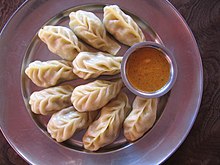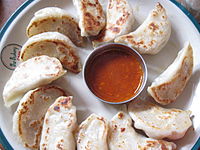Momo (food)
This article needs additional citations for verification. (June 2017) |
 A typical serving of a plate of momo with sesame yellow sauce and red ginger chilli pickle, known as "achaar" in Nepalese. 10th January is Nepal Momo Day. | |
| Type | Dumpling |
|---|---|
| Place of origin | Tibet and Nepal |
| Region or state | Nepal Tibet |
| Associated national cuisine | Nepalese cuisine Tibetan cuisine |
| Main ingredients | White-flour-and-water dough; meat, vegetable or cheese filling served with tomato and mayonnaise dip, tomato soup, soybean- perilla-peanut and sesame soup |
| Variations | Steam-momo, Kothey momo, Jhol momo, C-momo, Fry-momo, Open-momo, fried momo |
| 350 to 1000 (35 to 100 per piece) kcal | |
| Similar dishes | baozi, jiaozi, mantou, buuz, gyoza, mandu, manti |
Momo (Nepali: म:म:,Tibetan: མོག་མོག་, Wylie: mog mog) is a type of dumpling dish popular primarily in Nepal, India and Tibet. [1] Momo can be found in the cuisines of Nepal and Tibet. It is similar to baozi, jiaozi and mantou in Chinese cuisine, buuz in Mongolian cuisine, gyoza in Japanese cuisine, mandu in Korean cuisine and manti in Afghan cuisines.
Names[]
In Shanxi, where Jin Chinese is spoken, unfilled buns are often called momo (饃饃), which is simply the word for "steamed bun". The name momo spread to Nepal, Tibet and India and usually now refers to filled buns or dumplings.[2] Momo is the colloquial form of the Tibetan word "mog mog".[3] The different names for the dumpling include Assamese: মম; Bengali: মোমো; Hindi-Urdu: मोमोज़, موموز or ممتو; Nepali: मम; Nepal Bhasa: मम, small momo - ममचा; Tibetan: མོག་མོག་, Wylie: mog mog; simplified Chinese: 馍馍; traditional Chinese: 饃饃; pinyin: mómo.[4]
As for the Himalayan momo, the dish is believed to have spread to Nepal along with the influx of the Tibetan diaspora. Since this dish was initially popular among the Newar community of the Kathmandu Valley of Nepal, one prevalent belief[5] is that traveling Nepali Newar merchants took the recipe of momo from Tibet where the Nepali Newar Merchants used to go to trade and brought it back home to Nepal. In Tibet, the filling of the dish was typically meat, such as yak, due to the scarcity of vegetables in Tibet. However, after arriving in the Indo-Gangetic Plains, the momo was made vegetarian in the modern era to feed the large population of vegetarian Hindus.[1] Unproven, but substantiated by the dates and references to momo in colloquial references, the civil war in Nepal pushed out the Nepali diaspora to seek a livelihood in the Indian sub-continent, which further proliferated to the prevalence of Himalayan style momo in the southern half of the Indian sub-continent.
Description[]
Momo is a type of steamed dumpling with some form of filling. Momo has become a traditional delicacy in Nepal, Tibet, as well as among Nepalese and Tibetan communities in Bhutan, as well as people of the Indian regions of Darjeeling, Ladakh, Sikkim, Assam, Uttarakhand, Himachal Pradesh and Arunachal Pradesh. In Pakistan, Gilgit-Baltistan region it is known as mamtoo.
Production[]


A simple white-flour-and-water dough is generally preferred to make the outer momo covering. Sometimes, a little yeast or baking soda is added to give a more doughy texture to the finished product.
Traditionally, momo is prepared with ground/minced meat filling, but in the modern era, this has changed and the fillings have become more elaborate. These days, momo is prepared with virtually any combination of ground meat, vegetables, tofu, paneer cheese, soft chhurpi (local hard cheese) and vegetable and meat combinations.[6]
- Meat: Different types of meat fillings are popular in different regions. In Nepal, Tibet, Darjeeling district, Sikkim and Bhutan, pork, chicken, goat meat and buffalo meat are commonly used. In the Himalayan region of Nepal, India, lamb and yak meat are more common. Minced meat is combined with any or all of the following: onions/shallots, garlic, ginger and cilantro/coriander. Some people also add finely puréed tomatoes and soy sauce.[7]
- Vegetables: Finely chopped cabbage, carrot, soy granules, potato, flat bean (lilva kachori) or chayote (iskush) are used as fillings in India and Nepal.
- Cheese: Usually fresh cheese (paneer) or the traditional soft chhurpi is used. This variety is common in India and Eastern Nepal.
- Khoa: Momo filled with milk solids mixed with sugar are popular as a dessert in the Kathmandu valley.
The dough is rolled into small circular flat pieces. The filling is then enclosed in the circular dough cover either in a round pocket or in a half-moon or crescent shape. People prefer meat that has a lot of fat because it produces flavorful juicy momos. A little oil is sometimes added to the lean ground/minced meat to keep the filling moist and juicy. The dumplings are then cooked by steaming over a soup (either a stock based on bones or vegetables) in a momo-making utensil called mucktoo. The dumplings may also be pan-fried or deep-fried after being steamed.
Varieties[]
Momo are traditionally steamed but can also be deep-fried or pan-fried. Momo is usually served with chili garlic sauce and pickled daikon in Tibet. In Nepal, popular dipping sauces include tomato-based chutneys or sesame or peanut or soybean-based sauces. Sauces can be thick or thin consistency depending on the eatery (locally called chutney/achhar[8]), normally made with tomato or peanut and soybean as the base ingredient. In Kathmandu valley, the traditional way of serving momo (momochā) is 10 ping-pong ball sized round momo drowned in a sauce infused with Timur pepper (Nepali pepper, a variety of Sichuan pepper) called jhol.[9] Jhol momo has warm or hot broth poured over momo (not cooked in the broth).[10] One of the main ingredients of jhol achat is Nepali hog plum (lapsi), but if this is unavailable, lemon or lime juice may be used.
Soup momo or mok-thuk (Tibetan) is another way to serve momos where the momos are either cooked in broth for a type of dumpling soup or steamed momos are added to broth. Pan-fried momo is also known as kothey momo. Steamed momo served in hot sauce is called C-momo. There are also a variety of dumplings of Nepal found in the Indian state of Sikkim and Darjeeling district, including tingmo and thaipo.
Gallery[]

Momo in a mucktoo.
Kothey, a pan-fried momo variety from "The Bakery Cafe" in Nepal

C-momo/ chilli momo
North-East-Indian style momos from Darjeeling, India with garlic chutney

Jhol momo with buffalo's meat in Kathmandu.
See also[]
| Wikimedia Commons has media related to Momos. |
| Wikibooks Cookbook has a recipe/module on |
References[]
- ^ a b Lynelle Seow (15 January 2017). CultureShock! India. Marshall Cavendish International Asia Pte Ltd. pp. 202–. ISBN 978-981-4771-98-6.
- ^ Gordon, Stewart (2009). When Asia Was the World: Traveling Merchants, Scholars, Warriors, and Monks Who Created the "Riches of the "East" (Reprint ed.). Da Capo Press. p. 13. ISBN 978-0306817397.
- ^ Acta Orientalia Academiae Scientiarum Hungaricae. Akadémiai Kiadó. 1955. p. 209.
- ^ Jīn Péng 金鹏 (ed.): Zàngyǔ jiǎnzhì 藏语简志. Mínzú chūbǎnshè 民族出版社, Beijing 1983, p. 31. This is not the same as dumpling.
- ^ Sijapati, Alisha (September 17, 2016). "A Juicy Love Affair". Retrieved September 22, 2016 – via The Kathmandu Post.
- ^ "Taste of Nepal: Momos - म:म: Or मोमो (Dumplings)". 26 July 2013.
- ^ "Momo recipe". Himalayanlearning.org. Archived from the original on December 1, 2008. Retrieved April 6, 2011.
- ^ Williams, James. "Momos Chutney Recipe". ReciPickr.com.
- ^ Prixya (2015-02-05). "Recipe: Local Style Jhol Momo Achar". Recipe. Retrieved 2021-09-26.
- ^ "Anup's Kitchen | Traditional recipes, without shortcuts". Retrieved 2021-09-26.
- Dumplings
- Tibetan cuisine
- Bhutanese cuisine
- Newari cuisine
- Nepalese cuisine
- Pakistani cuisine
- Indian cuisine
- Fast food





